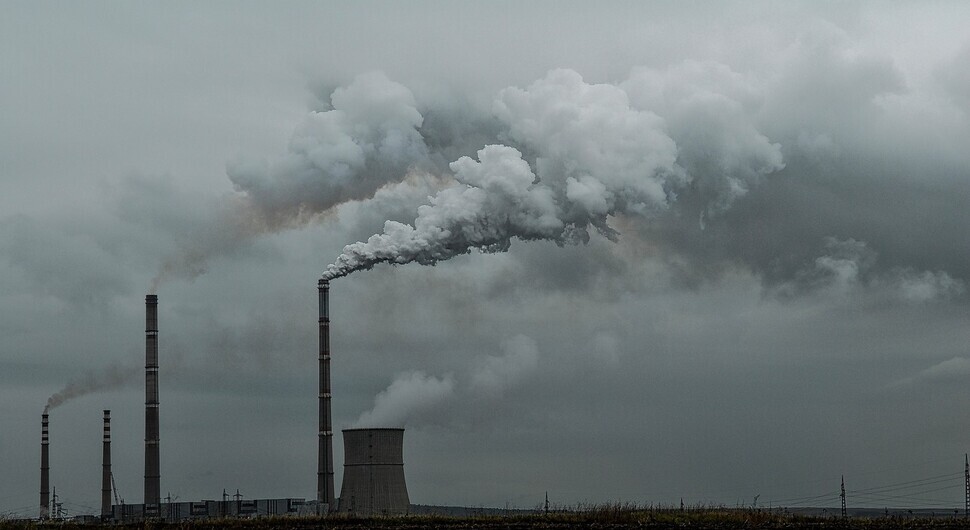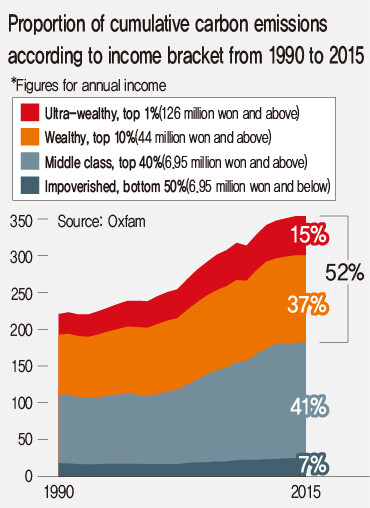hankyoreh
Links to other country sites 다른 나라 사이트 링크
Top 1% accounts for more than double the carbon emissions of bottom 50%, study finds

The lockdowns imposed by various countries seeking to combat the COVID-19 pandemic caused carbon dioxide emissions to plunge by 17% in early April relative to the previous year. That was the result of traffic being cut by more than 80% in most countries. The world’s richest 10% reportedly use 75% of energy in aviation, leading to the hope that, if the wealthy refrain from traveling, the world could move a step closer to the goal of “net zero” carbon emissions by 2050. In fact, the world’s richest 1% are responsible for double the carbon emissions of the poorest 50%, studies say.
These are some of the findings that appear in the report “Confronting Carbon Inequality,” which was released on Sept. 21 by Oxfam, an international aid and development organization, and the Stockholm Environment Institute, an international environmental research and policy institute.
“From 1990 to 2015 [. . .] the richest 10% of the world’s population (c. 630 million people) were responsible for 52% of the cumulative carbon emissions. [. . .] The richest 1% (c. 63 million people) alone were responsible for 15% of cumulative emissions [. . .] — twice as much as the poorest half of the world’s population,” said the report, which was published to coincide with a session of the UN General Assembly, which will be discussing global crises, including the climate crisis.

Cumulative carbon emissions for the 25-year period from 1991 to 2015 were similar to the total for the 140-year period from 1850 to 1989. Over the same years, global GDP doubled, but half the world’s population still earns a lower income than the minimum cost to sustain an appropriate living standard (US$5.50 per day). The report observed that “extreme carbon inequality [due to income inequality] in recent decades has brought the world to the climate brink.”
The richest 10% of the world’s population accounted for roughly a third (31%) of the “1.5C carbon budget” over the past 25 years -- representing the remaining amount of carbon dioxide that the world can emit while keeping the rise in global temperatures within 1.5°C. In contrast, the bottom 50% used just 4% of the available carbon budget.
“The inequality is such that the richest 10% alone would fully deplete [the carbon budget] by just a few years later, even if everyone else's emissions dropped to zero tomorrow,” the report said.
For the rise in global temperatures to be kept within 1.5°C, the per capita carbon emissions (carbon footprint) for the world’s population would need to average 2.1 tons per year through 2030. The per capita carbon footprint of the richest 1% is 30 times higher than the 2030 target -- and 100 times higher than that of the bottom 50%.
In terms of where to start with reducing carbon footprints, the report focused on the area of transport, which accounts for a quarter of global carbon emissions. According to the report, transport was “found to be the most unequal consumption category, with an income elasticity of demand much higher than 1 (i.e. if income increases 100%, spending on transport increases by more than 100%).”
The report explained, “Today's extreme carbon inequality is the result of political choices made over the past 20-30 years, a period dominated by neoliberal economic thinking and elite political capture that has seen income and wealth inequality in most countries soar, reflecting deeply entrenched systems of patriarchy and colonialism that prioritize domination and enrichment of some, at the cost of others.”
The report went on to call for the adoption of policy measures such as progressive carbon pricing -- including “carbon sales taxes on SUVs, private jets or super yachts, or levies on business class or frequent flights” -- as well as banning advertising in public spaces and ending tax exemptions on aircraft fuel and tax breaks for company cars.
By Lee Keun-young, staff reporter
Please direct comments or questions to [english@hani.co.kr]

Editorial・opinion
![[Column] When ‘fairness’ means hate and violence [Column] When ‘fairness’ means hate and violence](https://flexible.img.hani.co.kr/flexible/normal/500/300/imgdb/original/2024/0516/7417158465908824.jpg) [Column] When ‘fairness’ means hate and violence
[Column] When ‘fairness’ means hate and violence![[Editorial] Yoon must stop abusing authority to shield himself from investigation [Editorial] Yoon must stop abusing authority to shield himself from investigation](https://flexible.img.hani.co.kr/flexible/normal/500/300/imgdb/original/2024/0516/4417158464854198.jpg) [Editorial] Yoon must stop abusing authority to shield himself from investigation
[Editorial] Yoon must stop abusing authority to shield himself from investigation- [Column] US troop withdrawal from Korea could be the Acheson Line all over
- [Column] How to win back readers who’ve turned to YouTube for news
- [Column] Welcome to the president’s pity party
- [Editorial] Korea must respond firmly to Japan’s attempt to usurp Line
- [Editorial] Transfers of prosecutors investigating Korea’s first lady send chilling message
- [Column] Will Seoul’s ties with Moscow really recover on their own?
- [Column] Samsung’s ‘lost decade’ and Lee Jae-yong’s mismatched chopsticks
- [Correspondent’s column] The real reason the US is worried about Chinese ‘overcapacity’
Most viewed articles
- 1China calls US tariffs ‘madness,’ warns of full-on trade conflict
- 2[Column] US troop withdrawal from Korea could be the Acheson Line all over
- 3[Editorial] Yoon must stop abusing authority to shield himself from investigation
- 4[Column] When ‘fairness’ means hate and violence
- 5[Column] How to win back readers who’ve turned to YouTube for news
- 6US has always pulled troops from Korea unilaterally — is Yoon prepared for it to happen again?
- 7[Book review] Who said Asians can’t make some good trouble?
- 8Naver’s union calls for action from government over possible Japanese buyout of Line
- 9Could Korea’s Naver lose control of Line to Japan?
- 10[Editorial] Korea must respond firmly to Japan’s attempt to usurp Line